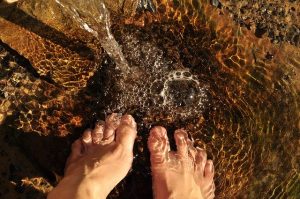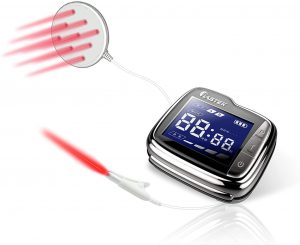LLLT (low level laser therapy) has been suggested for the treatment of a wide range of chronic pain disorders. Low level laser irradiation has been advocated for relief of many symptoms of inflammation, pain and is used in nerve regeneration and wound healing.
Type 2 diabetes is one of the most disabling and progressive diseases. The prevalence of both type 1 and type 2 diabetes worldwide is about 371 million people.
People living with diabetes mellitus may experience insensitivity or numbness to temperature changes and pain, cramps or sharp pains, a tingling, pricking or burning sensation, loss of coordination and balance, and extreme sensitivity to touch.
What is Diabetic Foot Syndrome?

Diabetic foot syndrome is the most prevalent cause of limb amputation in diabetic patients. This has a significant impact on diabetic patients’ quality of life and the national health system.
Diabetic foot ulcers are categorized according to severity as:
- Severe (accompanied by metabolic perturbations or systemic signs),
- Moderate (more extensive or deeper skin ulcers) or
- Mild (superficial or limited in depth and size).
Conventional treatment methods of diabetic ulcers include various kinds of wound cleaning skin grafting debridement, vasodilators, pain management, antibiotics, and even the use of fly maggots. However, even in multidisciplinary therapeutic treatment methods for diabetic foot syndrome, treatment results are usually unsatisfactory and treatment is often difficult.
Is Low Level Laser Therapy Effective in Alleviating the Symptoms of Diabetic foot Syndrome?

Low level laser irradiation, also known as soft laser is a treatment method that supplies bio-stimulative light energy to cells.
The laser energy is absorbed in order to stimulate atoms and molecules of cells without causing any significant changes in tissue temperature. LLLT (Low Level laser Therapy) is a pain-free, non-invasive treatment method with minimal side effects. There’s no single explanation of how laser therapy functions in the treatment of diabetic foot syndrome. However, there are several studies trying to examine various effects of low level laser therapy on tissue repair mechanisms.
Animal and cell studies conducted In vitro suggest that laser irradiation promote wound healing mainly as a result of improvement of various factors that play essential roles in tissue repair mechanisms. Moreover, histological and biometrical analysis show faster lesion contraction indicating reformed connective tissue and quicker re-epithelization with collagen fibers that are more organized in irradiated wounds.
Low level laser irradiation promotes proliferation of myofibroblasts and reduces inflammation in experimental cutaneous wounds. Growth of fibroblasts and an increase in cell division play a critical role especially in wound healing.
Researchers have tested different wavelengths of LILI (Low Intensity Laser Irradiation) on cellular proliferation, viability, and migration in both unwounded human skin and diabetic wounded fibroblast cells. Cells that were irradiated at 632,8 nm showed a significantly higher degree of ATP luminescence as well as migration and haptotaxis as compared to cells that were irradiated at 830 nm.
The results of this study show that diabetic wounded cells benefit more particularly in wound healing in the low level irradiation (visible range) than in the higher range (infrared). However, near infrared laser therapy might be beneficial for deep ulcers because it has a deeper penetration capacity compared to visible red light.
Both blue light laser (470 nm) and red light laser (630 nm) help improve perfusion by stimulating the release of nitric oxide, elevated keratin-10 mRNA level, and enhanced epithelialization. Blue light laser also facilitates the recovery of mitochondria that is inhibited by NO gas hence improving wound healing through the NO pathway. This also activates growth factors and increase keratin expression which induces endothelial cell migration.
The anti-inflammatory effects of low level laser irradiation can be explained by the inhibition of interleukin, cytokine, and prostaglandine in animal and cell models. Moreover, experiments with a low level laser (415nm) show an antibacterial effect on E.coli and S.aureus by induction of ROS.
Low level laser irradiation can also increase the blood flow velocity and diameter of the peripheral arterioles hence enhancing microcirculation. According to studies, LLLT showed positive results as a treatment method for diabetic foot ulcers.
Conclusion
Since most conventional therapies for treating diabetic foot syndrome are variable in their ability to offer complete healing, there’s need to develop alternative treatments that can accelerate or improve the healing process. Available studies show that LLLT is effective for most diabetes patients, easy to learn and cost effective. The studies give encouraging results and warrant further investigations in order to understand the exact mechanisms of low level laser irradiation effects particularly on diabetic ulcers.
Check out our article on the best lotions for circulation in diabetic feet!

